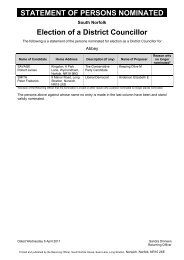Section 3: Place Making and Design Principles [PDF] - South Norfolk ...
Section 3: Place Making and Design Principles [PDF] - South Norfolk ...
Section 3: Place Making and Design Principles [PDF] - South Norfolk ...
Create successful ePaper yourself
Turn your PDF publications into a flip-book with our unique Google optimized e-Paper software.
3.7.2 Car parking<br />
Soft l<strong>and</strong>scape should be integrated<br />
into parking areas. Wherever possible<br />
permeable paving should be used to<br />
minimise surface water run-off.<br />
Parking within the curtilage<br />
Parking within the curtilage should be<br />
set behind the building line so that cars<br />
do not dominate views along the street<br />
or from the houses themselves. T<strong>and</strong>em<br />
parking is preferred to side-by-side<br />
spaces as it has less impact upon the<br />
continuity of the street frontage.<br />
In-structure parking<br />
In-structure car parking can provide<br />
convenient spaces that are well<br />
integrated into the layout.<br />
Integral garages should not project<br />
forward of the front elevation of the<br />
dwelling. Wherever possible the houses<br />
should be wide enough to also provide<br />
a habitable room at ground level on the<br />
street frontage, or else the first floor will<br />
need to be designed to help overlook the<br />
street.<br />
Undercroft parking can provide either<br />
allocated or non-allocated spaces.<br />
Undercrofts must be designed so that<br />
there is a relationship between the<br />
lowest residential units <strong>and</strong> the street to<br />
provide surveillance.<br />
On street parking<br />
On-street parking is non-allocated<br />
parking. It is convenient for visitor <strong>and</strong><br />
short-term use, can animate the street<br />
<strong>and</strong> can help to calm traffic speeds.<br />
The layout <strong>and</strong> street space should be<br />
designed to accommodate it from the<br />
outset without letting it dominate.<br />
Courtyards<br />
Communal car parking areas should<br />
provide a maximum of 10 spaces to<br />
avoid the visual dominance of large<br />
areas of parking <strong>and</strong>/ or problems of<br />
a ‘lack of ownership’ <strong>and</strong> care of such<br />
spaces.<br />
Parking in rear courtyards must be<br />
designed with care to make sure that it is<br />
easy for residents to access their parking<br />
space.<br />
Where there are any homes in rear<br />
courtyards then the space must be<br />
designed to be part of the public realm,<br />
not only as a place for parking cars,<br />
so that it is an attractive residential<br />
environment. In the case of FoGs<br />
(flats over garages) the front door must<br />
be accessible without having to walk<br />
through parked cars.<br />
Possible evidence<br />
Layout drawing with parking spaces<br />
shown <strong>and</strong> numbered.<br />
For residential proposals, the numbering<br />
of parking spaces should relate to the<br />
numbering of residential units.<br />
A schedule of the overall numbers of<br />
parking spaces in relation to residential<br />
units/ floorspace of other uses.<br />
The <strong>Design</strong> & Access Statement should<br />
include a parking management strategy,<br />
or make reference to one where it<br />
is set out in a Transport Statement<br />
or Sustainable Travel Plan where<br />
appropriate.<br />
How is it evaluated?<br />
• Does the scheme provide safe<br />
convenient <strong>and</strong> attractive places for<br />
people to park their cars?<br />
• Is car parking well-integrated into the<br />
overall layout <strong>and</strong> design so that it<br />
does not dominate?<br />
• Do the proposals include a variety of<br />
parking options, such as spaces onstreet<br />
<strong>and</strong> also in courtyards?<br />
• Is a strategy proposed for managing<br />
car parking?<br />
Main Contents<br />
<strong>Section</strong> 3 Start<br />
3.1 Introduction<br />
3.2 Uses <strong>and</strong><br />
activities<br />
3.3 Accessibility<br />
3.4 Site assets<br />
3.5 Character<br />
3.6 Development<br />
form<br />
3.7 Public realm<br />
3.8 <strong>Design</strong><br />
quality<br />
3.9 Performance<br />
3.10 Worked<br />
example<br />
164


![Section 3: Place Making and Design Principles [PDF] - South Norfolk ...](https://img.yumpu.com/28189284/44/500x640/section-3-place-making-and-design-principles-pdf-south-norfolk-.jpg)
![List of outstanding appeals against planning decisions [PDF, 30 Kb]](https://img.yumpu.com/51294693/1/190x135/list-of-outstanding-appeals-against-planning-decisions-pdf-30-kb.jpg?quality=85)
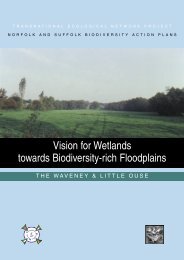
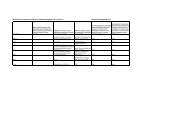
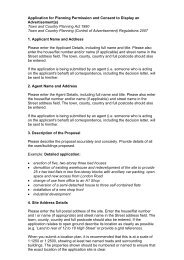
![Brown bin calendar - week 2 [PDF] - South Norfolk Council](https://img.yumpu.com/49352110/1/184x260/brown-bin-calendar-week-2-pdf-south-norfolk-council.jpg?quality=85)
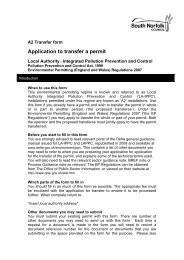

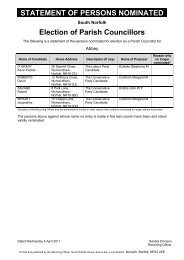
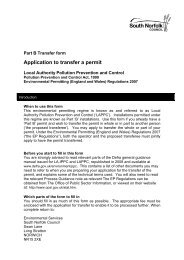
![Link magazine, Spring 2008 [PDF, 4,450k] - South Norfolk Council](https://img.yumpu.com/43994858/1/184x260/link-magazine-spring-2008-pdf-4450k-south-norfolk-council.jpg?quality=85)
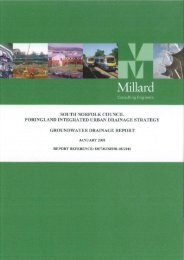
![South Norfolk Council Volunteering Opportunities [PDF]](https://img.yumpu.com/42079564/1/184x260/south-norfolk-council-volunteering-opportunities-pdf.jpg?quality=85)
![Tiffey Valley Guide [PDF, 1,450k] - South Norfolk Council](https://img.yumpu.com/41615145/1/124x260/tiffey-valley-guide-pdf-1450k-south-norfolk-council.jpg?quality=85)
![Queen's Diamond Jubilee Fund [PDF] - South Norfolk Council](https://img.yumpu.com/41088331/1/184x260/queens-diamond-jubilee-fund-pdf-south-norfolk-council.jpg?quality=85)
